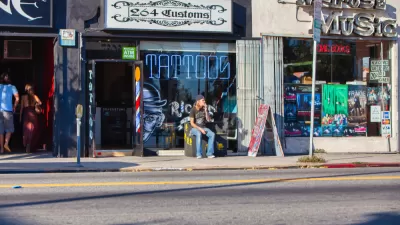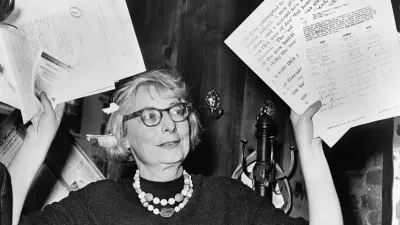Jane Jacobs, often viewed as the patron saint of the progressive urban planning world, maybe be given too much credit, according to this piece from Andrew Manshel.
"Her views have now been broadly adopted and it is conventional wisdom in planning circles that participatory neighborhood planning is best, that preservation of old buildings is essential, and that in cities the car is bad. But Jacobs had a tendency toward sweeping conclusions based on anecdotal information, and some of them were overblown and/or oblivious to the facts. Perhaps most graphically, Jacobs predicted that the grand arts center planned for the Upper West Side of Manhattan would fail. But Lincoln Center turned out to be a great success-igniting the revitalization of the entire neighborhood.
More revealingly, the Greenwich Village she held out as a model for city life has become some of the highest-priced real estate in New York City-it's no longer the diverse, yeasty enclave she treasured. Ultimately, many of the policies she advocated blocked real-estate development-causing prices of existing housing stock to rise and pricing out all but the wealthiest residents."
Manshel suggests that more attention be given to the ideas of William H. Whyte.
FULL STORY: Enough With Jane Jacobs Already

Maui's Vacation Rental Debate Turns Ugly
Verbal attacks, misinformation campaigns and fistfights plague a high-stakes debate to convert thousands of vacation rentals into long-term housing.

Planetizen Federal Action Tracker
A weekly monitor of how Trump’s orders and actions are impacting planners and planning in America.

San Francisco Suspends Traffic Calming Amidst Record Deaths
Citing “a challenging fiscal landscape,” the city will cease the program on the heels of 42 traffic deaths, including 24 pedestrians.

Defunct Pittsburgh Power Plant to Become Residential Tower
A decommissioned steam heat plant will be redeveloped into almost 100 affordable housing units.

Trump Prompts Restructuring of Transportation Research Board in “Unprecedented Overreach”
The TRB has eliminated more than half of its committees including those focused on climate, equity, and cities.

Amtrak Rolls Out New Orleans to Alabama “Mardi Gras” Train
The new service will operate morning and evening departures between Mobile and New Orleans.
Urban Design for Planners 1: Software Tools
This six-course series explores essential urban design concepts using open source software and equips planners with the tools they need to participate fully in the urban design process.
Planning for Universal Design
Learn the tools for implementing Universal Design in planning regulations.
Heyer Gruel & Associates PA
JM Goldson LLC
Custer County Colorado
City of Camden Redevelopment Agency
City of Astoria
Transportation Research & Education Center (TREC) at Portland State University
Jefferson Parish Government
Camden Redevelopment Agency
City of Claremont





























